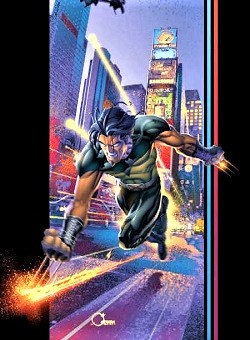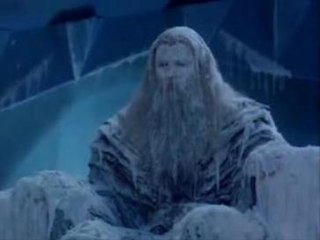
The Hulk is a superhero appearing in American comic books published by Marvel Comics. Created by writer Stan Lee and artist Jack Kirby, the character first appeared in the debut issue of The Incredible Hulk. In his comic book appearances, the character, who has dissociative identity disorder (DID), is primarily represented by the alter ego Hulk, a green-skinned, hulking and muscular humanoid possessing a limitless degree of physical strength, and the alter ego Dr. Robert Bruce Banner, a physically weak, socially withdrawn, and emotionally reserved physicist, both of whom typically resent each other.

Rick Jones is a fictional character appearing in American comic books published by Marvel Comics. The character has been depicted as a sidekick and friend to the Hulk, Captain America, Mar-Vell / Captain Marvel, Rom the Spaceknight, and Genis-Vell / Captain Marvel.

Elizabeth "Betty" Ross is a character appearing in American comic books published by Marvel Comics. Created by Stan Lee and Jack Kirby, the character first appeared in The Incredible Hulk #1 (1962) as a romantic interest of the Hulk. She is the daughter of General Thaddeus E. "Thunderbolt" Ross. Over the years, the character has undergone multiple transformations, including the Harpy and Red She-Hulk.

The Incredible Hulk is an American television series based on the Marvel Comics character the Hulk. The series aired on the CBS television network and starred Bill Bixby as Dr. David Banner, Lou Ferrigno as the Hulk, and Jack Colvin as Jack McGee.

The Leader is a supervillain appearing in American comic books published by Marvel Comics. The Leader first appeared in Tales to Astonish #62, created by writer Stan Lee and artist Steve Ditko as the archenemy of the Hulk. He has mainly appeared in Hulk-related comic books over the years and was one of the featured characters in the Marvel NOW! Thunderbolts relaunch.

Doc Samson is a fictional character appearing in American comic books published by Marvel Comics. The character is usually depicted as a superhero and psychiatrist in the Marvel Universe, known as a supporting character in stories featuring the Hulk.

Wolverine is a fictional character appearing in books published by Marvel Comics. He is an alternative version of Wolverine that appears in the Ultimate Marvel imprint, in stories separate from the original character. Created by writer Mark Millar and artist Adam Kubert, Ultimate Wolverine first appeared in Ultimate X-Men #1.
"Planet Hulk" is a Marvel Comics storyline that ran primarily through issues of The Incredible Hulk starting in 2006. Written by Greg Pak, it dealt with the Marvel heroes' decision to send the Hulk away, his acclimation to and conquest of the planet where he landed, and his efforts to return to Earth to take his revenge.

Hercules and the Circle of Fire is the third television movie in the syndicated fantasy series Hercules: The Legendary Journeys.

"World War Hulk" is a comic book crossover storyline that ran through a self-titled limited series and various titles published by Marvel Comics in 2007, featuring the Hulk.

The Lady Liberators, also called the Liberators, is a superhero team appearing in American comic books published by Marvel Comics. The original team's only appearance was in Avengers volume 1 #83, written by Roy Thomas, with art by John Buscema and Tom Palmer. The original team was a one-off group, lasting only a single issue and meant to satirize what was perceived to be extreme feminism, though it is also now seen as an early example of the Scarlet Witch as a feminist character.

Skaar is a fictional character, a comic book superhero appearing in American comic books published by Marvel Comics, usually as a supporting character in stories featuring his father, the Hulk, who conceived Skaar with the extraterrestrial Caiera during the 2006–2007 "Planet Hulk" storyline. Created by writer Greg Pak and artist John Romita Jr., the earliest version of the character appeared in a cameo in an alternate history story in What If? Planet Hulk #1, in which the character was drawn by Rafa Sandoval. The Earth-616 version of the character appeared in World War Hulk #5, by Pak and Romita, Jr.

Brian Banner is a fictional character appearing in American comic books published by Marvel Comics. The character was created by Bill Mantlo, first appearing in The Incredible Hulk vol. 2 #312. He is the abusive father of Bruce Banner, with said abuse being a major contributing factor of Bruce's eventual transformation into the Hulk.

The Maestro is a fictional supervillain appearing in American comic books published by Marvel Comics. Created by writer Peter David and artist George Pérez, the character first appeared in The Incredible Hulk: Future Imperfect#1. Depicted as an evil version of the Hulk from an alternate future, the Maestro possesses Bruce Banner's intelligence and the Hulk's strength and more malevolent personality traits.

Ultimate Human is an American comic book limited series published by Marvel Comics. The limited series set in the Ultimate Universe, is written by Warren Ellis and pencilled by Cary Nord.

Old Man Logan is an alternative version of the fictional character Wolverine appearing in American comic books published by Marvel Comics. This character is an aged version of Wolverine set in an alternate future universe designated Earth-807128, where the supervillains overthrew the superheroes. Introduced as a self-contained story arc within the Wolverine ongoing series by writer Mark Millar and artist Steve McNiven, the character became popular with fans. After the death of Wolverine, Laura Kinney took the Wolverine mantle but an Old Man Logan from the similar Earth-21923 was brought in to serve as an X-Man and featured in his own ongoing series.

"Fall of the Hulks" is a 2010 comic book crossover storyline published by Marvel Comics. It ran throughout the ongoing Hulk and Incredible Hulk series, as well as a self-titled limited series; featuring the Hulk and various members of his supporting cast.
Rebecca Banner is a fictional character, a supporting character appearing in American comic books published by Marvel Comics. She is the mother of Bruce Banner, who would grow up to be the gamma-powered superhero known as the Hulk.

Bruce Banner is a fictional character in the Marvel Cinematic Universe (MCU) media franchise originally portrayed by Edward Norton and subsequently by Mark Ruffalo—based on the Marvel Comics character of the same name—known commonly by his alter ego, the Hulk. Banner is depicted as a genius physicist who after a failed experiment to replicate a super soldier program using gamma radiation, transforms into a large, muscular creature with green skin whenever his heart rate goes above 200 beats per minute or when facing mortal danger. As the Hulk, he possesses superhuman abilities, including increased strength and durability.
















